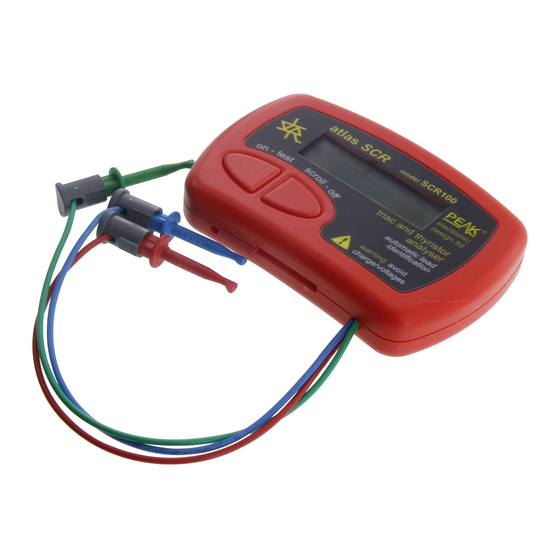Table of Contents
Advertisement
Quick Links
Advertisement
Table of Contents

Subscribe to Our Youtube Channel
Summary of Contents for Peak Atlas SCR100
- Page 1 Triac and Thyristor Analyser Model SCR100 (Firmware: 4.0) Designed and manufactured with pride in the UK User Guide © Peak Electronic Design Limited 2004/2021 In the interests of development, information in this guide is subject to change without notice. E&OE...
-
Page 2: Table Of Contents
Atlas SCR100 User Guide November 2021 – Rev 9 Want to use it now? We understand that you want to use your SCR100 right now. The unit is ready to go and you should have little need to refer to this user guide, but please make sure that you do at least... -
Page 3: Introduction
Atlas SCR100 User Guide November 2021 – Rev 9 Introduction The Peak Atlas SCR100 is an advanced instrument designed specifically for the analysis of SCR (Thyristor) and Triac devices. Summary Features: • Automatic component identification (Thyristor or Triac). • Automatic pinout identification. -
Page 4: Safety Considerations
Atlas SCR100 User Guide November 2021 – Rev 9 Safety Considerations WARNING: This instrument must NEVER be connected to powered equipment/components or equipment/components with any stored energy (e.g. charged capacitors). Failure to comply with this warning may result in personal injury, damage to the equipment under test, damage to the SCR100 and invalidation of the manufacturer's warranty. -
Page 5: Analysing Components
Atlas SCR100 User Guide November 2021 – Rev 9 Analysing Components The SCR100 is designed to analyse discrete, unconnected, unpowered Triacs and Thyristors. This ensures that external connections don’t influence the measured parameters. The three test probes can be connected to the component any way round. -
Page 6: Scrs
Atlas SCR100 User Guide November 2021 – Rev 9 Silicon Controlled rectifiers (Thyristors) The SCR100 will analyse almost any SCR provided that a gate trigger current of no more than 90mA is required. The three test clips can be connected to SCR detected the device under test any way round. -
Page 7: Triacs
Atlas SCR100 User Guide November 2021 – Rev 9 Triacs The SCR100 will analyse almost any Triac, provided that it requires a gate trigger current of no more than 90mA. The three test clips can be connected to the device under test any way round. -
Page 8: Notes On Scrs (Thyristors) And Triacs
Atlas SCR100 User Guide November 2021 – Rev 9 Notes on SCRs and Triacs Silicon Controlled Rectifiers (Thyristors) SCR Turn-On SCRs (Thyristors) act as a controlled diode. They block reverse current between the cathode (K) and the anode (A) at all times, and they conduct in the forward direction only when triggered by a pulse of current to the control (gate) terminal. - Page 9 Atlas SCR100 User Guide November 2021 – Rev 9 Notes on SCRs and Triacs Triacs Triacs are a well established technology, designed specifically for the solid-state control of AC loads. They offer bi-directional load current switching (for both half cycles of the mains supply) and also bi-directional gate current capability to trigger the device.
-
Page 10: Gate Sensitivity
Atlas SCR100 User Guide November 2021 – Rev 9 Gate Sensitivity The SCR100 attempts to trigger the device under test at nine discrete gate currents, in ascending order. First test Trigger level 1 100A Trigger level 2 Trigger level 3... -
Page 11: Gate Voltage
Atlas SCR100 User Guide November 2021 – Rev 9 Gate Voltage If the SCR100 has successfully tested a triac or thyristor, it will be able to display the gate voltage as well as the gate sensitivity. The gate voltage is the voltage measured across the gate and the cathode (for a thyristor) or across the gate and MT1 for a triac. -
Page 12: Care Of Your Scr100
Atlas SCR100 User Guide November 2021 – Rev 9 Care of your SCR100 The SCR100 should provide many years of service if used in accordance with this user guide. Care should be taken not to expose your unit to excessive heat, shock or moisture. -
Page 13: Self Tests
Atlas SCR100 User Guide November 2021 – Rev 9 Self Test Procedure Each time the SCR100 is powered up, a self test procedure is performed. In addition to a battery voltage test, the unit measures the performance of many internal functions such as the voltage and current sources, amplifiers, analogue to digital converters and test lead multiplexers. -
Page 14: Appendix A - Accessories
If your probes become damaged, you may wish to purchase a new set of probes. Replacement Battery Replacement Alkaline AAA batteries are available from Peak Electronic Design Limited, your local agent or any good electronics store. All accessories are available from Peak Electronic Design Limited or an authorised agent. Page 14... -
Page 15: Appendix B - Technical Specifications
Atlas SCR100 User Guide November 2021 – Rev 9 Appendix B - Technical Specifications All values are at 20C unless otherwise specified. Parameter Minimum Typical Maximum Note Peak test current into S/C 100mA 120mA Peak test voltage across O/C 11.0V 12.0V... -
Page 16: Appendix C - Statutory Information
More details can be obtained from your national WEEE recycling agency. At Peak Electronic Design Ltd we are committed to continual product development and improvement. The specifications of our products are therefore subject to change without notice.












Need help?
Do you have a question about the Atlas SCR100 and is the answer not in the manual?
Questions and answers